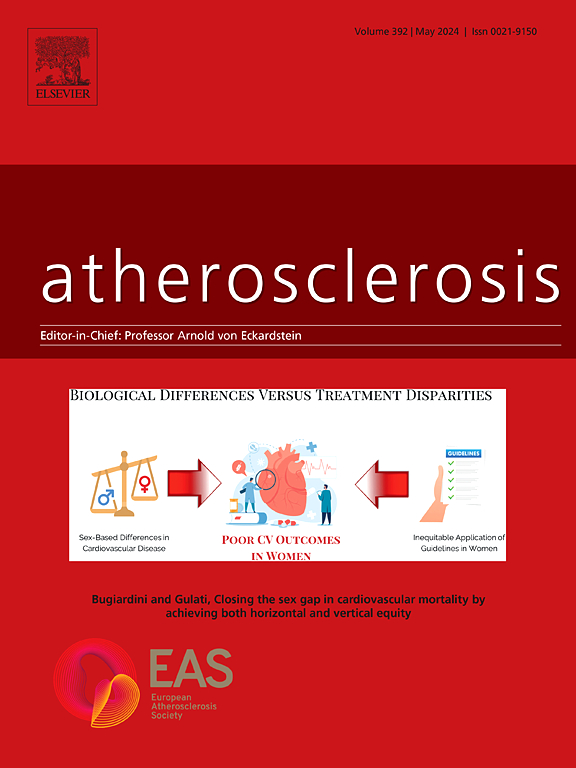Elevated triglycerides are related to higher residual cardiovascular disease and mortality risk independent of lipid targets and intensity of lipid-lowering therapy in patients with established cardiovascular disease
IF 5.7
2区 医学
Q1 CARDIAC & CARDIOVASCULAR SYSTEMS
引用次数: 0
Abstract
Background and aims
Despite optimal management of low-density lipoprotein cholesterol (LDL-C), substantial residual cardiovascular risk persists in patients with cardiovascular disease (CVD), which may be attributed to other atherogenic lipoproteins. We tested the hypotheses that elevated triglycerides (TGs) are related to higher residual CVD and mortality risk in patients with established CVD, and that such relationships depend on guideline-recommended lipid target achievement, high-density lipoprotein cholesterol (HDL-C) levels, and intensity of lipid-lowering therapy (LLT).
Methods
In a prospective cohort study of 9436 patients with manifest CVD, the relationships between log-transformed TG levels and recurrent cardiovascular events and all-cause mortality were analyzed overall using Cox regression models. Subsequently, analyses were stratified by achievement of low-density lipoprotein cholesterol (LDL-C) and non-HDL-C treatment goals, HDL-C levels, and LLT intensity.
Results
During a median follow-up of 9.0 years (IQR 4.5–14.1), 2075 recurrent cardiovascular events, 736 myocardial infarctions, 586 strokes, 1231 cardiovascular deaths, and 2729 all-cause deaths occurred. Per 1-unit higher log-TG level, the hazard ratio was 1.17 (95 % CI: 1.07–1.28) for recurrent cardiovascular events, 1.34 (1.16–1.56) for myocardial infarction, 1.10 (0.92–1.30) for stroke, 1.23 (1.09–1.38) for cardiovascular mortality, and 1.12 (1.03–1.21) for all-cause mortality. These hazard ratios did not depend on achievement of LDL-C and non-HDL-C treatment goals, HDL-C levels, or LLT intensity (all p for interaction ≥0.05).
Conclusions
Elevated TGs are related to higher residual CVD and mortality risk in patients with established CVD. These relationships were unrelated to guideline-recommended lipid target achievement, HDL-C levels, and LLT intensity.

在已确诊的心血管疾病患者中,甘油三酯升高与较高的残余心血管疾病和死亡风险相关,与脂质靶点和降脂治疗强度无关。
背景和目的:尽管对低密度脂蛋白胆固醇(LDL-C)进行了最佳管理,但心血管疾病(CVD)患者仍存在大量残留的心血管风险,这可能归因于其他致动脉粥样硬化的脂蛋白。我们检验了甘油三酯(TGs)升高与已确诊CVD患者较高的残余CVD和死亡风险相关的假设,并且这种关系取决于指南推荐的脂质目标的实现、高密度脂蛋白胆固醇(HDL-C)水平和降脂治疗(LLT)的强度。方法:对9436例CVD患者进行前瞻性队列研究,采用Cox回归模型对对数转化TG水平与心血管复发事件和全因死亡率之间的关系进行综合分析。随后,通过实现低密度脂蛋白胆固醇(LDL-C)和非HDL-C治疗目标、HDL-C水平和LLT强度对分析进行分层。结果:在中位随访9.0年(IQR 4.5-14.1)期间,发生了2075例复发性心血管事件,736例心肌梗死,586例中风,1231例心血管死亡和2729例全因死亡。log-TG每升高1个单位,心血管事件复发的风险比为1.17 (95% CI: 1.07-1.28),心肌梗死的风险比为1.34(1.16-1.56),卒中的风险比为1.10(0.92-1.30),心血管死亡率的风险比为1.23(1.09-1.38),全因死亡率的风险比为1.12(1.03-1.21)。这些风险比不依赖于LDL-C和非HDL-C治疗目标的实现、HDL-C水平或LLT强度(相互作用的p均≥0.05)。结论:TGs升高与已确诊CVD患者的残留CVD和死亡风险升高有关。这些关系与指南推荐的脂质目标实现、HDL-C水平和LLT强度无关。
本文章由计算机程序翻译,如有差异,请以英文原文为准。
求助全文
约1分钟内获得全文
求助全文
来源期刊

Atherosclerosis
医学-外周血管病
CiteScore
9.80
自引率
3.80%
发文量
1269
审稿时长
36 days
期刊介绍:
Atherosclerosis has an open access mirror journal Atherosclerosis: X, sharing the same aims and scope, editorial team, submission system and rigorous peer review.
Atherosclerosis brings together, from all sources, papers concerned with investigation on atherosclerosis, its risk factors and clinical manifestations. Atherosclerosis covers basic and translational, clinical and population research approaches to arterial and vascular biology and disease, as well as their risk factors including: disturbances of lipid and lipoprotein metabolism, diabetes and hypertension, thrombosis, and inflammation. The Editors are interested in original or review papers dealing with the pathogenesis, environmental, genetic and epigenetic basis, diagnosis or treatment of atherosclerosis and related diseases as well as their risk factors.
 求助内容:
求助内容: 应助结果提醒方式:
应助结果提醒方式:


